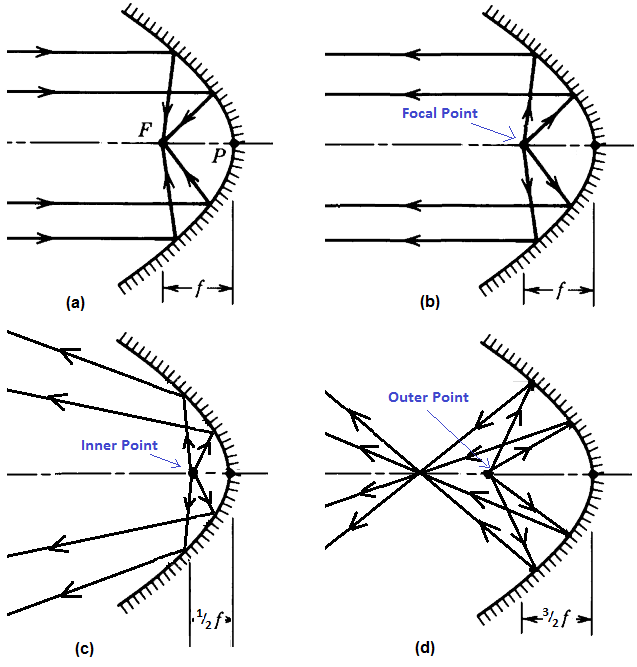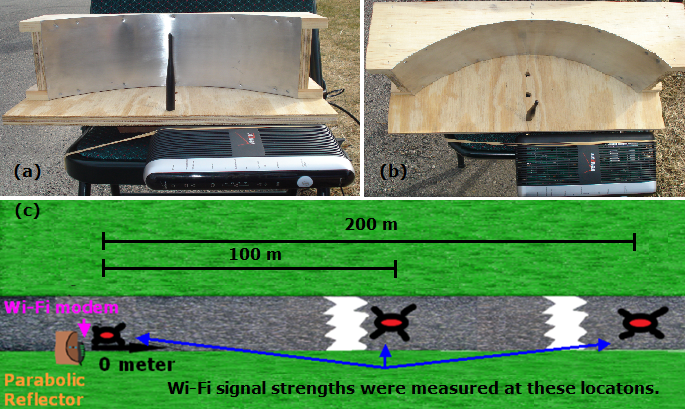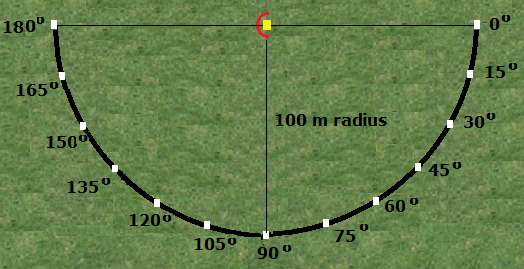-
Paper Information
- Paper Submission
-
Journal Information
- About This Journal
- Editorial Board
- Current Issue
- Archive
- Author Guidelines
- Contact Us
Journal of Wireless Networking and Communications
p-ISSN: 2167-7328 e-ISSN: 2167-7336
2013; 3(2): 13-17
doi:10.5923/j.jwnc.20130302.02
A Novel and Versatile Parabolic Reflector that Significantly Improves Wi-Fi Reception at Different Distances and Angles
David Li
Department of Science, Commack High School, 1 Scholar Lane, Commack, NY 11725, USA
Correspondence to: David Li, Department of Science, Commack High School, 1 Scholar Lane, Commack, NY 11725, USA.
| Email: |  |
Copyright © 2012 Scientific & Academic Publishing. All Rights Reserved.
A novel and versatile parabolic reflector with three fitting positions at the Focal, Inner (= focal length), and Outer (=
focal length), and Outer (= focal length) points was designed, built, and tested for its impact on Wi-Fi signal strengths at different distances and angles. This easy-to-build and inexpensive device significantly boosted the Wi-Fi reception at different distances and improved the signal strengths at different angles. A trade-off between the signal strength and the angle, at which the signals could be received, was observed. When positioned at the Focal point, the reflector boosted the Wi-Fi signals the most, but only at a narrow angle from 0º to 60º. Conversely, when positioned at the Inner or Outer points, the reflector improved the Wi-Fi signals at lesser degrees, but at a much larger angle from 0º to 165º. The parabolic reflector was able to shield the Wi-Fi signals from unintended users when positioned at Angle 180º. The versatile design of the reflector allowed it to be positioned for different purposes, i.e., providing better signals for multiple users at different locations by utilizing the Inner or Outer points, or maximizing signal strength and privacy to a single user by using the Focal point.
focal length) points was designed, built, and tested for its impact on Wi-Fi signal strengths at different distances and angles. This easy-to-build and inexpensive device significantly boosted the Wi-Fi reception at different distances and improved the signal strengths at different angles. A trade-off between the signal strength and the angle, at which the signals could be received, was observed. When positioned at the Focal point, the reflector boosted the Wi-Fi signals the most, but only at a narrow angle from 0º to 60º. Conversely, when positioned at the Inner or Outer points, the reflector improved the Wi-Fi signals at lesser degrees, but at a much larger angle from 0º to 165º. The parabolic reflector was able to shield the Wi-Fi signals from unintended users when positioned at Angle 180º. The versatile design of the reflector allowed it to be positioned for different purposes, i.e., providing better signals for multiple users at different locations by utilizing the Inner or Outer points, or maximizing signal strength and privacy to a single user by using the Focal point.
Keywords: Parabola, Reflector, Wi-Fi, Reception, Signal, Focal
Cite this paper: David Li, A Novel and Versatile Parabolic Reflector that Significantly Improves Wi-Fi Reception at Different Distances and Angles, Journal of Wireless Networking and Communications, Vol. 3 No. 2, 2013, pp. 13-17. doi: 10.5923/j.jwnc.20130302.02.
Article Outline
1. Introduction
- When Alex Hills and his team at Carnegie Mellon University built the world’s first big wireless networks in the mid-1990s, which later became the prototype of modern Wi-Fi networks, human society had entered the era of wireless communications[1][2]. In the past decades, the Wi-Fi technology has experienced exponential development [3][4], and has now become very popular as laptops, tablets, smart phones, and other mobile devices emerge and are used extensively. While Wi-Fi networks offer many advantages over typical wired local area networks (LANs), such as convenience and mobility, they also present several drawbacks[5]. One of them is the limited range. Wi-Fi signals are carried on radio waves, which lose strength with increasing distance. The typical range of a common IEEE 802.11b or 802.11g network with standard equipment is on the order of tens of meters, although the newer 802.11n standard networks deliver more than double that range[6]. While adequate for a typical home, these Wi-Fi ranges are insufficient in large structures, such as a corporate building, school, hospital, and apartment building or even a large residential house. Another issue with Wi-Fi is low privacy and limited security compared to wired LANs[7][8]. Wi-Fi signals travel in all directions in the air (non-directional). The chance of being compromised by a dedicated adversary is higher than with wired LANs. There are also other problems associated with Wi-Fi[9]. To solve these issues and improve Wi-Fi’s performance and security, various methods and tips have been used, which include buying a new router and adding a wireless repeater[10], utilizing a new range extender[11], implementing a HomePlug device[12], building a do-it-yourself parabolic reflector[13], establishing an instant network[14], and installing the WPA2 security and changing channels[15]. In search for an inexpensive and practical way to increase the Wi-Fi range and security, an easy-to-build parabolic reflector with a novel and versatile design was built and tested on a home Wi-Fi system. The results were reported herein.
2. Design of the Parabolic Reflector
- A parabola is a curve defined as the locus of points that are equidistant from a point, commonly known as the focal point, and a line, known as the directrix. When a reflective material is formed into the shape of a parabola, it will then have the useful property of focusing all incident rays that are parallel to its axis onto the focal point, and vice versa (Figures 1a and 1b) [16]. Wi-Fi signals are carried on radio waves, commonly at 2.4 GHz, and obey the law of reflection, in which the angle of incidence is equal to the angle of reflection. A parabola-shaped reflector should be able to make the Wi-Fi waves more directional and thus stronger with increased security and privacy by reflecting all the scattered rays emitted from the focal point into a beam of straight and parallel rays (Figure 1b).
 , derived from the directrix-focus form. Then, the equation was differentiated to be
, derived from the directrix-focus form. Then, the equation was differentiated to be . Points on the parabola were selected and they were each connected to the point in which the signal originated (at 10 units away, 15 and 5). The angle of the line segments was then measured against the tangent line at that point and angle of the reflected ray was calculated by the law of reflection.
. Points on the parabola were selected and they were each connected to the point in which the signal originated (at 10 units away, 15 and 5). The angle of the line segments was then measured against the tangent line at that point and angle of the reflected ray was calculated by the law of reflection.3. Building of the Parabolic Reflector
- According to the design in Figure 2a, a parabolic reflector was built using wood and sheet aluminum. Aluminum was chosen as a suitable material because of its high reflectance to electromagnetic waves across a broad range of wavelengths[17].
3.1. Materials
- Sheet aluminium (15 × 45 × 0.2 cm), ply wood, and tools, such as band saw and nail gun were purchased from the Home Depot® store. Drawing tools, i.e., ruler, protractor, and pencil, were from the Staples® store.
3.2. Building Process
- A parabola template was drawn on paper according to the design in Figure 2a. Following the template, a wood frame was made using band saw and nail gun. Three 1.27 cm-diameter holes were drilled at Focal (at 10 cm focal length), Inner (1/2 focal length), and Outer (3/2 focal length) points on the bottom of the frame. The aluminium sheet was later mounted onto the frame using nail gun to afford the completed product shown in Figure 2b.
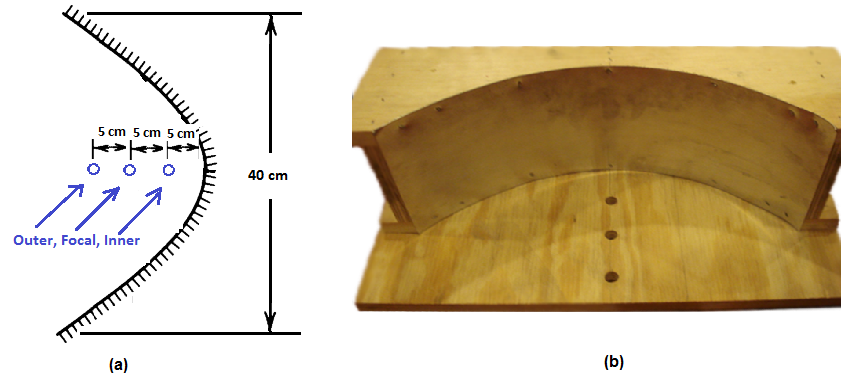 | Figure 2. (a) A novel parabolic reflector with three fitting positions was designed. (b) The parabolic reflector was built out of sheet aluminium and wood |
4. Testing of the Parabolic Reflector
- To test how this parabolic reflector would affect the Wi-Fi reception, two sets of experiments measuring signal strengths at different distances and angles were designed and carried out. The Wi-Fi system used for the experiments was Verizon’s FiOS[18], and the modem was Actiontec® Verizon FiOS Router Model# MI424WR[19]. A laptop computer installed with the Xirrus Wi-Fi Inspector software [20] was used to measure the Wi-Fi parameters in both experiments.
4.1. Effect of the Parabolic Reflector on Wi-Fi Signal Strengths at Different Distances
- This initial set of experiments tested how the parabolic reflector would boost the signal strengths and extend the signal ranges.
4.1.1. The Experiment
- The effect of the parabolic reflector on Wi-Fi signal strengths at different distances was examined. The experiments were carried out on an obstruction-free straight street (Figure 3c). The signal strengths (in dBm) were measured in front of the reflector on the axis of the parabola (defined as Angle 0º) at three different distances (0, 100, 200 m) away from the Wi-Fi modem when the reflector was positioned at the Focal, Inner, or Outer point, respectively (Figures 3a and 3b). The signal strength measured without the parabolic reflector was used as the control group.
4.1.2. The Results and Discussion
- The results were shown in Figure 4. It was found that the parabolic reflector boosted the Wi-Fi signals at all distances tested, but to varied degrees, no matter where it was positioned: at the Focal, Inner, or Outer points, compared to the control group. At 0 m, the signal strengths were improved the most from -51 dBm of the control group to -47, -48, and -49 dBm, respectively, for the Focal, Inner, and Outer point groups. At 100 m, the signal improvement was largest when the reflector was positioned at the Focal point from -66 to -57 dBm, translating into 7.9-fold boost of the signal power according to the dBm to mW conversion equation: P(mW) = 10(P(dBm)/10)[21]. At both Inner and Outer points, the signal strengths were improved at the same degrees from -66 to -64 dBm. When the distance was further out at 200 m, the directionality of the reflector became weaker and there was no difference in signal strength among the Focal, Inner, and Outer points. The signal improvements were the same from -73 to 70 dBm. Among all three positions, the reflector at the Focal point performed the best at all three distances by increasing the signal powers by 2.5, 7.9, and 2.0 folds, respectively at 0, 100, and 200 m.
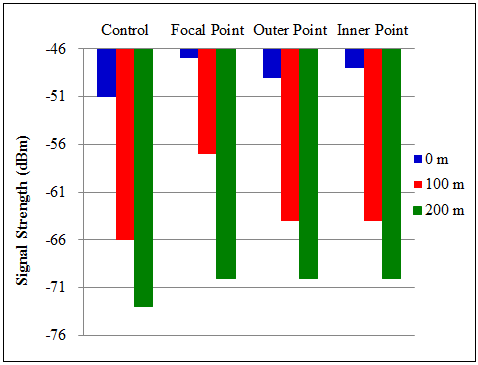 | Figure 4. Effects of the parabolic reflector on Wi-Fi signal strengths at different distances when positioned at the Focal, Outer, or Inner points |
4.2. Effect of the Parabolic Reflector on Wi-Fi Signal Strengths at Different Angles
- This was the second set of experiments to test how the parabolic reflector would perform at different angles.
4.2.1. The Experiment
- The effect of the parabolic reflector on Wi-Fi signal strengths at different angles was tested. The experiments were carried out on an obstruction-free grass field (Figure 5).The signal strengths were measured around a semicircle of 100 m radius with an interval of 15º, i.e., data were recorded at 0º, 15º, 30º, …, 180º with the Wi-Fi modem and the parabolic reflector assembly placed at the center. The reflector was positioned at the Focal, Inner, or Outer point. The signal strength measured without the parabolic reflector was used as the control group.
4.2.2. The Results and Discussion
- The results were shown in Figure 6. Data from 180º to 360º (= 0º) were extrapolated from those of 0º to 180º. It was found that among all experiment groups, signal strengths were boosted and hindered the most at Angle 0º and Angle 180º, respectively, when the antenna of the Wi-Fi modem was positioned at the Focal point. The former increased the signal strength from -80 to –70 dBm, translating into 10-fold increase of the signal power, and the latter decreased the signal strength from -80 to -89 dBm, translating into 7.9-fold decrease of the signal power.
 | Figure 6. Effects of the parabolic reflector on Wi-Fi signal strengths (in dBm) at different angles when positioned at the Focal, Outer, and Inner points |
5. Conclusions
- A novel, versatile, easy-to-build, and inexpensive parabolic reflector was designed, built, and tested for its effect on Wi-Fi signal strengths at different distances and angles. It was demonstrated that this parabolic reflector, through its directionality, could significantly boost Wi-Fi signals at different distances and certain angles when positioned at the Focal, Inner, or Outer point. This directional property became weaker as distance increased. For example, there were little improvements and diminished differences among the Focal, Inner, and Outer points at 200 m. A compromise was observed between the degree of signal improvement and the angle at which signals could be received. When the parabolic reflector was positioned at the Focal point, the signal strengths were improved the most, but only at a narrow angle from 0º to 60º. On the contrary, when positioned at the Inner or Outer points, the parabolic reflector could boost the Wi-Fi signals at much wider angle from 0º to 165º, but at a lesser degree. Among all experimental groups, the signals were improved the most when the reflector was positioned at the Focal point and signals measured in front of the reflector on the axis of the parabola (Angle 0º). The signals were hindered the most when measured in the back on the axis of the parabola (Angle 180º or faced backwards). The former property could be used for achieving stronger signals and an extended range, and the latter for improving privacy and security by shielding Wi-Fi signals from unintended users.This novel and versatile parabolic reflector was inexpensive and easy-to-build from common materials available from home improvement stores. This reflector had found real-life uses, such as being used in homes to boost Wi-Fi reception. Furthermore, it could be positioned for different purposes. For example, if designed for multiple users at different locations, the reflector should be positioned at the Inner or Outer points so that a wider angle of Wi-Fi reception could be achieved. Conversely, if users are at a single location, it should be positioned at the Focal point to achieve strongest signals and longest range. If security and privacy were needed, the parabolic reflector could be used to shield signals from unintended users by positioning it at Angle 180º.
ACKNOWLEDGEMENTS
- Advice and assistance from my science research advisors Mr. Sean Mahoney and Ms. Nicole Fuchs, my math teacher Mr. Thomas Shea and technology teachers Mr. Jordan Jankowski and Mr. John Murray of Commack Middle School are acknowledged. Thanks also go to Dr. Lorraine Solomon, Mr. Richard Kurtz, and Ms. Jeanette Collette of Commack High School, and Mrs. AlisonOfferman-Celentano, the Science Director of Commack School District, for helpful discussions and support.
 Abstract
Abstract Reference
Reference Full-Text PDF
Full-Text PDF Full-text HTML
Full-text HTML